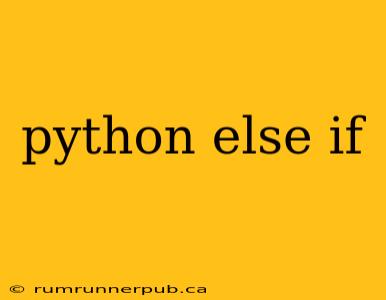Python doesn't have a dedicated "else if" keyword like some other languages (e.g., C++, Java). Instead, it uses elif, a concise and elegant way to handle multiple conditional branches. This article will explore elif in detail, drawing upon insights from Stack Overflow to provide a clear and comprehensive understanding.
Understanding elif
The core functionality of elif is to provide a chain of conditional checks. If the initial if condition is false, Python proceeds to evaluate the elif conditions sequentially. Only the first true condition's block of code will be executed. If none of the conditions are true, the else block (if present) is executed.
Example:
age = 25
if age < 18:
print("You are a minor.")
elif age < 65:
print("You are an adult.")
else:
print("You are a senior citizen.")
In this example, since age is 25, the first if condition is false, but the elif condition (age < 65) is true. Therefore, "You are an adult." will be printed. The else block is skipped.
Stack Overflow Insights and Elaboration
Many Stack Overflow questions revolve around the correct usage and understanding of elif. Let's analyze a few common scenarios:
Scenario 1: Nested if vs. elif
A common question on Stack Overflow addresses the choice between nested if statements and elif. While both achieve conditional branching, elif offers improved readability and efficiency when dealing with mutually exclusive conditions.
Example illustrating the difference:
Nested if:
x = 10
if x > 5:
if x < 15:
print("x is between 5 and 15")
elif equivalent:
x = 10
if x <=5:
print("x is less than or equal to 5")
elif x < 15:
print("x is between 5 and 15")
else:
print("x is greater than or equal to 15")
The elif version is cleaner and more directly expresses the intended logic. Nested if can become difficult to read and maintain as the number of conditions increases. (This example was inspired by various Stack Overflow discussions regarding nested if statements and their alternatives.)
Scenario 2: Handling Multiple Conditions Efficiently
Stack Overflow frequently features questions regarding optimizing conditional logic. elif is crucial in this context. Consider a scenario where you need to assign a grade based on a score:
score = 85
if score >= 90:
grade = "A"
elif score >= 80:
grade = "B"
elif score >= 70:
grade = "C"
elif score >= 60:
grade = "D"
else:
grade = "F"
print(f"Your grade is: {grade}")
This approach is far more efficient than a series of nested if statements. It ensures only one grade is assigned, avoiding potential logical errors.
Beyond the Basics: Practical Applications
elif is fundamental to many Python programming tasks, including:
- Menu-driven programs: Create interactive programs where user input determines the program's flow.
- Game development: Implement game logic based on player actions and game state.
- Data validation: Check user input to ensure it conforms to specific criteria.
- Error handling: Handle different types of exceptions based on their nature.
Conclusion
Python's elif provides a structured and readable way to implement multiple conditional checks. Understanding its usage is critical for writing efficient and maintainable Python code. By leveraging the insights from Stack Overflow and applying the examples provided here, you can confidently incorporate elif into your Python projects. Remember to always prioritize code clarity and efficiency when constructing your conditional logic.
